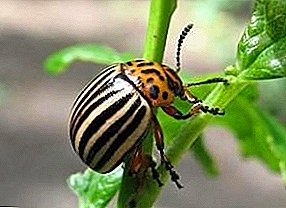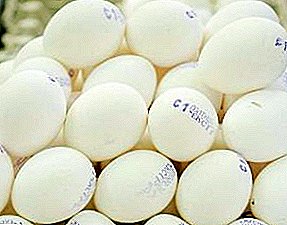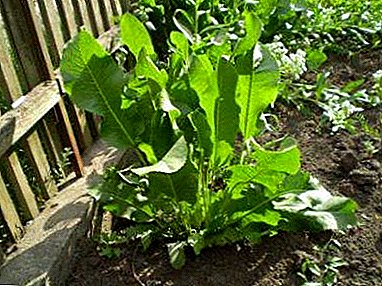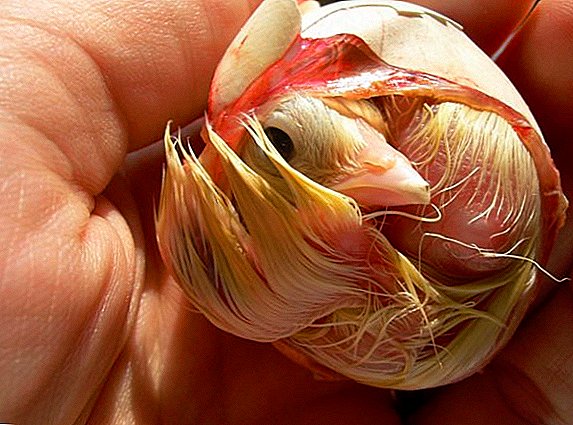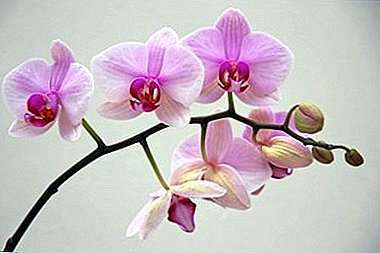
Orchid lovers appreciate them, first of all, for their luxurious blooming beauty. That is why the plant that does not want to please the eye causes its owner a lot of questions related to the methods of forcing the peduncle and its preservation up to the disclosure of flowers.
Why, at home, the orchid is stubborn, does not want to bloom and show itself in all its glory, as surely make it re-bloom - we will tell in the article. You can also watch a useful video on this topic.
When does home flowering occur?
Different varieties of orchids begin to bloom at different ages. Usually the first buds appear when the flower is 1.5-3 years old. You can find out the age of an orchid by its shoots: if the plant is 2 years old or more, there should be at least 5-8 of them.
After the orchid has bloomed, and its peduncle has dried, it is possible to wait for the next flowering not earlier than in 2-3 months. This fact is due to the fact that a healthy plant with proper care can generate flower stalks only 2-3 times a year, and the duration of the flowering itself is usually about 3 months. However, not all orchids are subject to the general rules, and the reason for this is often the wrong conditions for their maintenance and ignorance of the owners how to act correctly to achieve flowering.
Why doesn't it start for a long time?
There are several reasons why an orchid is more than a year or even two in no hurry to please its owner with flowers.
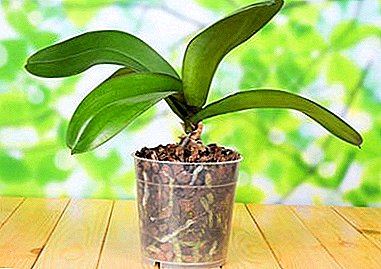 Any types of orchid plants do not like moving in space. Even the pot turned to the source of light by the other side becomes a serious stress for them. As a result of rotation and rearrangement of the plant from place to place, there may be delays in the appearance of the peduncle, as well as the falling away of already established buds.
Any types of orchid plants do not like moving in space. Even the pot turned to the source of light by the other side becomes a serious stress for them. As a result of rotation and rearrangement of the plant from place to place, there may be delays in the appearance of the peduncle, as well as the falling away of already established buds.- A common reason why an orchid does not bloom may be the lack of light in its root system. It is the roots that provide the complete photosynthesis of the whole plant, therefore it is necessary to plant flowering orchids only in transparent pots.
- An orchid will never bloom if it does not have enough light. Therefore, for the flowering of this plant, it is important to provide him with the appropriate level of illumination. On winter days, LED-lamps come to the rescue, which will help extend the daylight for the required amount of time (as a rule, orchids require 10 hours of bright light for regular flowering).
- The lack of daily and seasonal temperature fluctuations in the room also leads to a delay in the blooming of orchids. All that is needed in this case for flowering is to create a plant as close to natural conditions as possible, taking care that at night the air temperature is 4-6 ° C lower than during the day. An excellent solution would be to create an artificial wintering for a green pet for at least 20 days at a temperature of 5-10 ° C above zero.
Do I need to artificially stimulate the plant?
For for a newly transplanted orchid to give large and bright flowers, care should be taken to artificially stimulate its flowering.. It is important to make sure that the plant is completely healthy, has strong roots and powerful and fleshy leaves.
- Most often, orchid blooms are stimulated by placing it in a stressful situation. If the plant is beginning to "be lazy" and has not released the flower stem for a long time, you can try to push it to flowering with the help of watering. To do this, immerse the pot in water heated to 40-45 ° C and leave it there for 30 minutes.
- A hot shower is a useful stimulant for orchid flowering. Put the plant in the bath and spill its leaves and roots with a very warm stream of water (the temperature must be tolerable for the hands, otherwise you can burn the roots and leaves!).
- If the orchid has never bloomed, despite the appropriate age, as well as the quantity and quality of the shoots, you can try sending it for a week or two to a cool balcony (the room temperature should not fall below 0 ° C). This procedure simulates the wintering of the plant in natural conditions, thereby bringing its flowering period closer. After you bring the flower back to the house, a flower stalk will appear on it soon.
9 important rules for flowering
Experienced orchid owners recommend that you follow 9 simple rules to ensure their timely and abundant flowering.. Here's what to do:
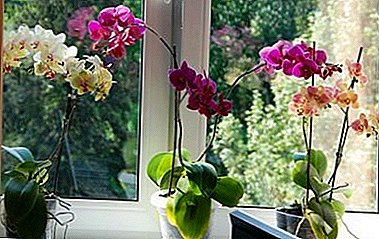 It should give the orchid grow. Normally, if it does not bloom before 3 years of age. The young plant is still not strong enough, and premature flowering can lead to his death.
It should give the orchid grow. Normally, if it does not bloom before 3 years of age. The young plant is still not strong enough, and premature flowering can lead to his death.- For planting green darling is important to use only transparent pots. This will ensure the full participation of the roots in photosynthesis, which is necessary for healthy growth and flowering. It is best to choose a perfectly smooth glass or plastic container. Clay pots will not be able to pass the light, and their rough inner surface will lead to the fact that the roots of the flower simply grow to it and are injured during the subsequent transplant.
- Do not move the plant from place to place. Especially - at the time of flowering orchids. If a change of position is still necessary, the plant should be provided with the usual temperature and light conditions.
- Orchid plants require a lot of sunny color. An orchid standing in the twilight will never bloom. However, the plant will require light shading from direct sunlight.
- Orchids do not like excessive moisture, so their watering should be moderate (1 time in 10-12 days). Otherwise, the roots may start to rot and the plant will die.
- You should not put an orchid in a draft: a plant can not only refuse to give peduncles, but also completely discard buds that have already been released.
- For the full development of orchids, you must use specialized fertilizers based on potassium and phosphorus.
- Orchids are tropical plants and require constant irrigation from a spray bottle.
- If a healthy orchid does not bloom for a long time, it is worth it to stress. To do this, you can remove the plant in a dark place, leave for the night in the cold, bathe the roots in hot water. After such manipulations, the flower will certainly sprout.
Why does not give buds and does not increase the leaves?
Most often, a stop in development and growth is associated with a lack of fertilizers. In order to stimulate active growing season, the leaves of the plant should be treated with a special phalaenopsis fertilizer. After the vegetative function is fully restored, the plant will increase the necessary green mass and, if properly maintained, will delight the owner with a young peduncle.
If leaves only roots and leaves
 If the orchid does not bloom, but leaves the leaves, it may be in a dormant period.. As a rule, the rest time of orchid plants lasts from 1.5 to 3 months, for which the plant should be provided with a cooler temperature regime.
If the orchid does not bloom, but leaves the leaves, it may be in a dormant period.. As a rule, the rest time of orchid plants lasts from 1.5 to 3 months, for which the plant should be provided with a cooler temperature regime.
If there is no flowering for more than three months, it is necessary to deal with the mode of watering, as well as humidity and temperature in the room where the orchid is kept. It is necessary to adjust the conditions of detention and create stressful conditions for the plant to successfully forge the peduncle.
We recommend to watch the video about the reasons for the absence of orchid flowering when growing leaves:
How to force to give buds by changing the watering?
Especially important for successful orchid flowering irrigation mode. How to accelerate flowering by changing the watering? Water the plant should be by fully immersing the pot in water. To dry the substrate qualitatively saturated with moisture, it is necessary to pull the pot out of the decorative flowerpots and immerse it in water for 3-5 minutes. After watering, the plant should be pulled out, let the excess water drain from the pot and put it in its original place.
Such manipulations need to be done once every two weeks in winter and once every 10 days in summer. More frequent bathing can lead to rotting of the root system and the disease, and sometimes the complete death of the plant.
Orchids to a humid subtropical climate, so it is important to maintain high humidity in the roomwhere they are grown. Spray the plant should be daily, using a well-settled warm and soft water.
How to stimulate by adjusting the length of daylight?
Board: The reason for the reluctance of the orchid to bloom may lie in the lack of light. Care must be taken to ensure that the plant is lit at least 10-12 hours a day. To ensure this condition, a fitolamp of a suitable spectrum that does not dry air is quite suitable.
Despite the orchids' light-loving nature, they should not be put on the south windows in the summer: there they can get sunburn and temperature burn. In addition, any plant needs a nightly rest phase to properly implement the process of photosynthesis, so do not forget the plant under the included phytolamp for the night.
Conclusion
Orchids are magnificent in their beauty plants that can thank for fantastic flowering for the correct observance of simple rules for caring for them. Using some tricks in the organization of the maintenance regime of the pet, each orchid owner will certainly achieve its abundant flowering.


 Any types of orchid plants do not like moving in space. Even the pot turned to the source of light by the other side becomes a serious stress for them. As a result of rotation and rearrangement of the plant from place to place, there may be delays in the appearance of the peduncle, as well as the falling away of already established buds.
Any types of orchid plants do not like moving in space. Even the pot turned to the source of light by the other side becomes a serious stress for them. As a result of rotation and rearrangement of the plant from place to place, there may be delays in the appearance of the peduncle, as well as the falling away of already established buds. It should give the orchid grow. Normally, if it does not bloom before 3 years of age. The young plant is still not strong enough, and premature flowering can lead to his death.
It should give the orchid grow. Normally, if it does not bloom before 3 years of age. The young plant is still not strong enough, and premature flowering can lead to his death.